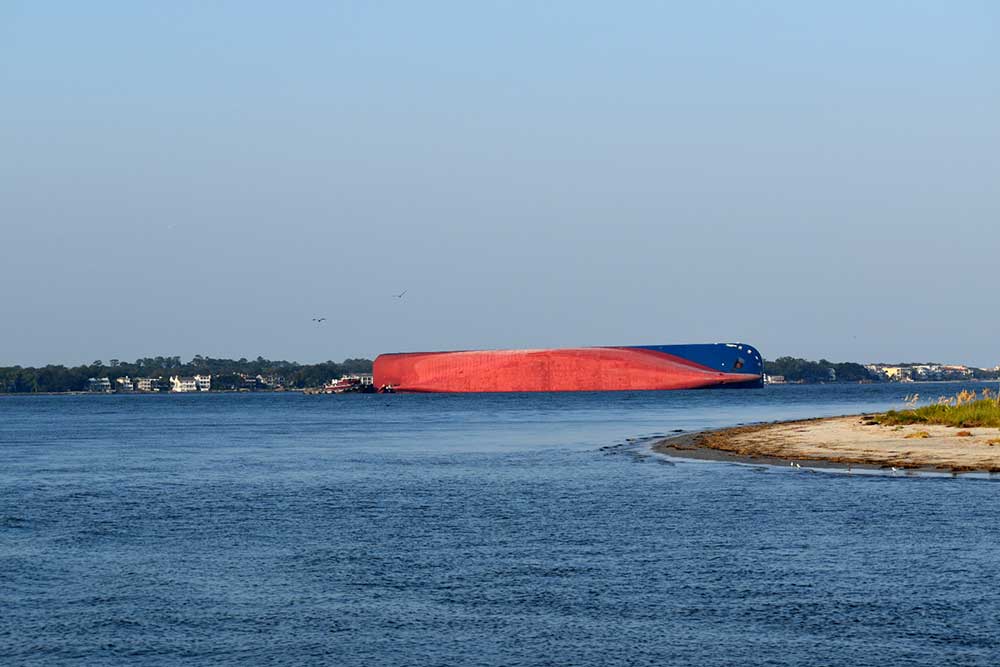In 1879 the salt marshes east of Brunswick inspired Georgia poet Sidney Lanier to compose “The Marshes of Glynn,” a poem later memorized statewide by generations of Georgia schoolchildren. Undoubtedly, many of these children had never seen the marshes for themselves. But they carried with them Lanier’s vivid description of a day in the life of the marsh and his deep reverence for creation. Unfortunately, since September 8, 2019, a great monolith has interrupted Lanier’s sweeping vista of the marshes bordering St. Simons Sound. The M/V Golden Ray, a 656-foot long car carrier, departed the port of Brunswick with 4,200 cars aboard only to suffer a fire, lose stability, and capsize just off the southern end of St. Simons Island. The cause is still under investigation.
Fortunately, all crew members were saved. Now comes the hard part: removing the ship from the busy channel along with all its contents — especially around 300,000 gallons of fuel, diesel, and lubricants carried by the ship and the gasoline and oil in its cargo of automobiles. Removing the ship’s fuel is particularly challenging because it is lying on its port side rather than upright. Imagine trying to accomplish that for an average car, half-submerged, but with a fuel capacity multiplied thousands of times.
The St. Simons Sound Incident Unified Command, an interagency response team of federal, state, and local agencies along with marine service contractors, moved quickly to skim leaking oil from surface waters, to place booms to protect sensitive marsh areas from oil coming ashore, and to plug submerged vents which began leaking fuel out instead of taking air in. Despite their best efforts, fuel has been spotted along more than 30 miles of marsh and coastline and there were reports of oiled birds.
Three weeks after the capsize, the scene on the north end of Jekyll looked normal that afternoon. People walked their dogs and picked up shells. Others had set up shop by the waterline. Lounging in folding chairs, they hoped the incoming tide would bring a bite on their fishing rigs. But instead of seeing the St. Simons pier across the water, their view was the dull-red antifouling paint on the ship’s keel, topped by the navy-blue livery of its hull. A busy flotilla of vessels swarmed around the ship. At the St. Simons pier, tourists and locals alike gathered to gawk at the spectacle of the Golden Ray’s white flat upper deck.
At the pier, I overheard one woman tell a companion that she had heard they were getting ready to right the ship, so she had hurried down to watch. She has a long wait ahead of her. In the weeks following my visit, major fuel leaks continued to challenge the response team, not only from the standpoint of water and air pollution but also in cleaning up oil that the tides sent deep into the marsh. By the end of October, the decision was made that the ship could not be salvaged. Instead it will be sliced vertically like a loaf of bread, from the bottom up. Once freed, each slice will be carried away for scrap. In the meantime, seagoing excavating equipment strategically placed a blanket of 6,000 tons of Georgia granite beneath the hull to resist the twice-daily ebb and flow of the tide shifting the sands beneath it — to hold the ship where it rests in the shallows alongside the channel.
Depending on your perspective, it’s fortunate that there are engineering firms which have the expertise to deal with this situation. Thus far in 2019, this is the sixth major incident involving a car carrier somewhere in the world. But each accident has its own challenges, and it will be months before work begins. And once it begins, new threats will emerge for our coast.
The Altamaha Riverkeeper (ARK), One Hundred Miles (OHM), and other local environmental groups responded quickly to the incident and continue to monitor the area from land, sea, and air. They have enlisted the expertise of UGA microbiologist Dr. Samantha Joye, an expert on the impacts of oil in coastal environments. She continues her work on the 2010 Deepwater Horizon oil spill in the Gulf of Mexico. Now her expertise is being put to use closer to home to document and analyze this situation as it develops. The local groups continue to share their findings in collaboration with the interagency response team.
“This disaster is a reminder that our communities need to be prepared when catastrophe occurs,” says Megan Derosiers, president and chief executive officer of One Hundred Miles. “Groups like ARK and OHM stand ready to monitor and react to unplanned events, but more importantly, they work every day with local and state government officials to ensure plans are in place to respond to and prevent these incidents. We all must remain vigilant and informed about the Golden Ray’s impact on our wildlife and environment, the businesses who rely on it every day, and the residents who value their connections to it in so many ways.” Fletcher Sams, the Altamaha Riverkeeper’s executive director, echoes this sentiment, “Without being alarmists, we are trying to make sure our community is kept whole through this.”
That community encompasses more than coastal residents. All Georgians have a stake in ensuring there is minimal impact to this coast that belongs to us all. Or as Sidney Lanier described it, “the length and the breadth and the sweep of the marshes of Glynn.”
*****
The public may subscribe here for official updates from the St. Simons Sound Response; Click here for the Altamaha Riverkeeper’s map of oil impacts in the marsh.

